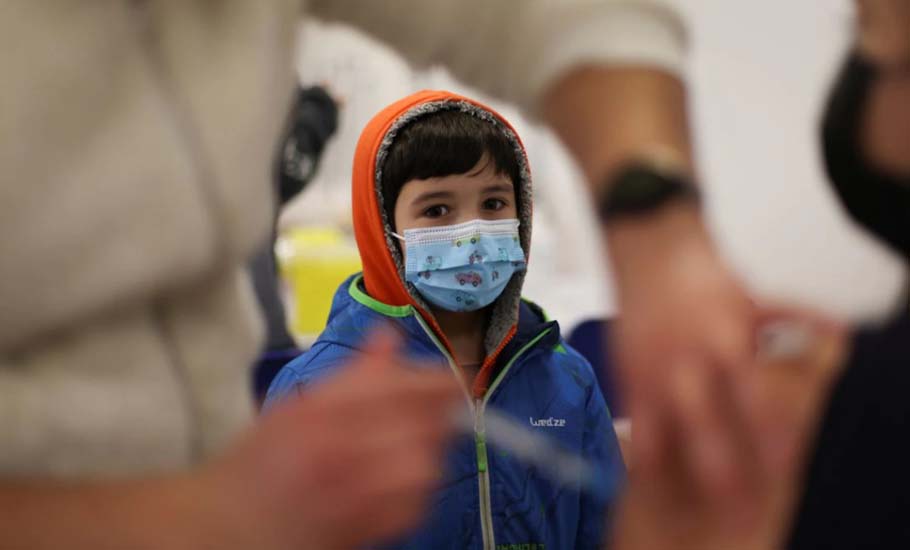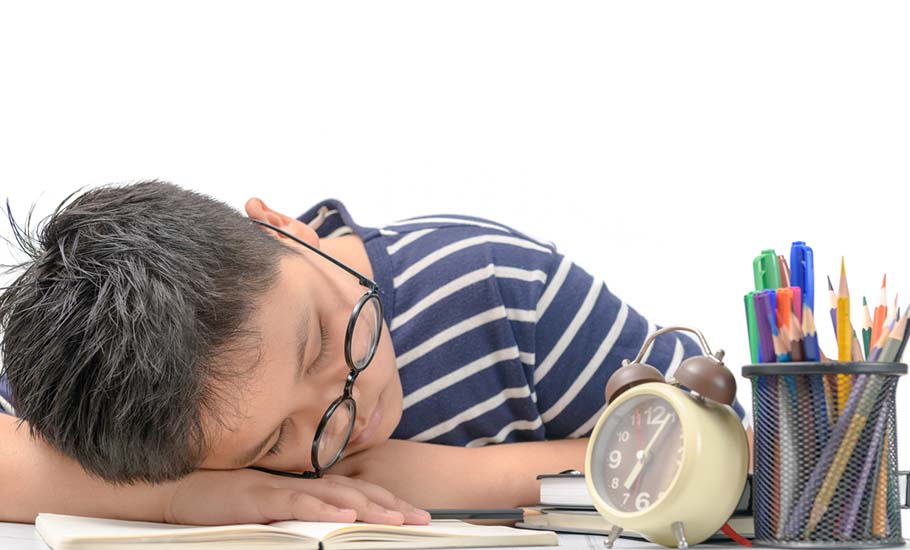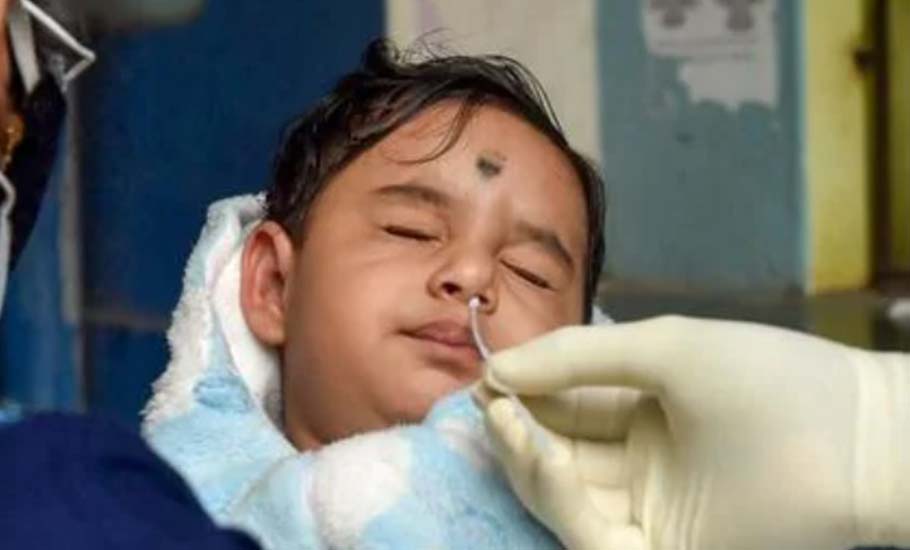
- Home
- News
- Analysis
- States
- Perspective
- Videos
- Education
- Entertainment
- Elections
- World Cup 2023
- Features
- Health
- Business
- Series
- Economy Series
- Earth Day
- Kashmir’s Frozen Turbulence
- India@75
- The legend of Ramjanmabhoomi
- Liberalisation@30
- How to tame a dragon
- Celebrating biodiversity
- Farm Matters
- 50 days of solitude
- Bringing Migrants Home
- Budget 2020
- Jharkhand Votes
- The Federal Investigates
- The Federal Impact
- Vanishing Sand
- Gandhi @ 150
- Andhra Today
- Field report
- Operation Gulmarg
- Pandemic @1 Mn in India
- The Federal Year-End
- The Zero Year
- Premium
- Science
- Brand studio
- Home
- NewsNews
- Analysis
- StatesStates
- PerspectivePerspective
- VideosVideos
- Entertainment
- ElectionsElections
- Sports
- Loading...
Sports - Features
- BusinessBusiness
- Premium
- Loading...
Premium

Covid hit our kids the worst. The damage is more than just psychological

Two-year-old Anu spoke like any normal child her age would do—two to three words at a time, sometimes stringing them into phrases, clearly and loudly. When Covid-19 struck, her family was one of the first to step off the Vande Bharat flights in May 2020. The quarantine protocol then required 28 days of isolation in their house in Kerala’s Trichur. When a family member tested positive,...
Two-year-old Anu spoke like any normal child her age would do—two to three words at a time, sometimes stringing them into phrases, clearly and loudly. When Covid-19 struck, her family was one of the first to step off the Vande Bharat flights in May 2020. The quarantine protocol then required 28 days of isolation in their house in Kerala’s Trichur. When a family member tested positive, that was extended to another month. Anu’s folks continued to self-isolate, fearing irked neighbours may turn hostile. In effect, the family had minimal contact with the outside world for almost six months. Today, Anu has lost control over her speech. She refuses eye contact, gets agitated in the presence of strangers and has zero facial expressions. Anu is not autistic, but is showing many signs of autism.
Fourteen-year-old Ben was brought to a paediatrician in Trivandrum for insomnia, anger outbursts, irritability and the resultant tardiness in attending virtual school. Gradually, he opened up. The boy was devastated by the sudden financial crisis that rocked his peaceful home. Seeing his unemployed father turn into an alcoholic was too much. After a few sessions, he confessed that he had started drinking too. The situation spiralled out of control so quickly that today, Ben is being treated for substance abuse and depression.
In a preliminary study conducted by the Institute of Mental Health and Neurosciences (IMHANS), Kozhikode and the Kerala Sastra Sahitya Parishat (KSSP) among children in the 6-18 year age group after the lockdowns were partly lifted, parents reported weight gain in 48.5 per cent children and reduced physical activity in 36 per cent of them. As many as 45 per cent had changes in sleep pattern and 39 per cent reported changes in appetite. Around 15 per cent children had reported symptoms of eye strain such as watering, eye pain and headache etc.
Although the study could not be published because the pandemic protocol wrought severe restrictions on data collection and size sampling, the implications are loud and clear—our children need help.
“Children are the passive victims of this pandemic,” says Dr P Krishnakumar, director, IMHANS, Kozhikode.
Children belonging to specific age-groups have specific yardsticks for optimum mental and emotional development.
Critical periods are there for the development of different brain functions. For example, the formative years determine the language skills of a child. At two years, the child should be speaking more than 100 words. By age 4, he should be talking in four to five worded sentences. “When there is no opportunity to interact with the environment during the early years, it affects language development,” Dr Krishnakumar said.
Brain contains cells called neurons and the current concept is that formation of new neurons after birth is very rare and occurs in only in certain parts of the brain. It does not increase with age. Brain development and increase in size is mainly due to formation of new connections between the neurons. “These connections depend on stimulations from the environment. If certain external stimulations are absent, then development of the corresponding brain area may be affected. Walking, talking, comprehending, interacting with peers, mingling with strangers—each stimulation is responsible for sparking a different skill set.”
Experts say when a child is isolated, even if he was born with a normal brain, his development will not be normal. Inability to acquire age-appropriate social skills, impaired social interactions and language regression may all occur.

Similarly, with the adolescent age group, the brain is not yet ‘fully-cooked’ but is a “work in progress”. The frontal lobe of the brain, which is the part of the brain concerned with problem solving and decision-making skills, controlling impulses, ability to assess consequences of acts, is one of the last parts of the brain to complete maturity.
Social interaction is most crucial at this juncture.
Adolescence is also that phase in life when one’s identity evolves—like ‘who am I’ and ‘what am I going to become’. Critical thinking, creative thinking, gender identity, relationships develop during this stage. It is also deemed as a sensitive period for moral development—that phase in one’s life when one develops a moral stand on multiple global issues and feels the tendency to fraternise – politically, artistically and philosophically.
During lockdowns, when social distancing becomes the norm, all these functions get affected.
“For all of us, our closest friends are always the ones from our adolescence,” Dr Krishnakumar said. That reality may not hold much longer for the next gen.
According to Dr Mithun Joy, orthopaedic surgeon at Parett Hospital, Kottayam, “An unprecedented number of children between the age 10 and 16 are being brought to the OP complaining of aches, pains, general weakness and fibromyalgia.”
Muscular/skeletal development, he says, is all about movement. Popular notion that the bone is a static object is completely erroneous. “Bones not only get strengthened through motion alone, they need to create a continuous turnover of calcium.”
Although Vitamin D deficiency was a global reality even among adults way before the pandemic struck, the sudden spike of the problem in children is attributed entirely to lack of sunlight, prolonged inactivity and sedentary schooling. What usually happens is that people tend to self-medicate. In children, that can lead to alarming levels of toxicity.
“The WHO defines health as a state of complete physical, mental and social well-being and not merely the absence of diseases or infirmity,” says Dr Praveen KS, consultant paediatrician, Fort Taluk Hospital Trivandrum, who has also worked closely with many state governmental interventions into child health.
The OP records in most paediatric clinics have recorded an alarming increase over the last year in obesity-related complications, posture issues like lower back pain, neck pain and shoulder pain, recurring headaches and eye-related disorders and so on.
New addictions
Apart from that, isolated cases of children who became victims to gaming addictions, cyber bullying and even cyber-crime have also cropped up.
Fourteen-year-old Sabith Muhammad, a student in a government school at Koonthallur, Trivandrum, was found hanging in his room, allegedly after a video game went awry. A woman in Ernakulam lost Rs 2.93 lakh after her 14-year-old son used her mobile phone to play an online game. Assuming it was cyber fraud, she reported to the police who found that her own son was the culprit–he had spent the entire sum in 225 transactions ranging from Rs 50 to Rs 5,000. Two children in Kasargod, studying in the ninth and tenth grades, along with their cousin swindled Rs 1 lakh from their parent’s bank accounts to play a PUBG game.

Dr Praveen recalls the case of an adolescent girl who was reportedly distressed and agitated during online classes. Her teachers later found out that she was being blackmailed by a stranger who took a few photographs of her during a video-chat session. Luckily, the girl was responsive to the school’s intervention and the trauma was, thereby, short-lived.
That’s not all.
“The collateral damage that this pandemic has wreaked on our children is way more,” says Dr Praveen. The indirect effect of a parent’s loss of employment, families on financial brink, relocations to unfamiliar isolated environments, Covid-related anxieties, death of a grandparent or a parent, the undue stress of virtual learning, the digital divide between the haves and the have-nots, the loss of the free mid-day meal, the disruption of all government-backed nutritional and routine immunisation programmes–children bear the brunt of it all, silently and deeply.
Dr Varghese Punnoose, HOD of the Department of Psychiatry, Alappuzha Medical College, recalls the case of an adolescent girl who was brought to him for counselling. “She was reportedly defiant, oppositional and disobedient. A few sessions later, she revealed the reason behind her personality change. Her father, a Gulf NRI, had returned after losing his job. The already-prevalent but negligible marital disharmony between the parents escalated owing to the added financial strains. The father, without his wife’s consent, shifted both daughters from their private school to a government one. The move was the final nail and the older daughter rebelled furiously against it,” Dr Punnoose recalls.
Today, the entire family is seeking therapy, individually and in teams.
“What we call externalising symptoms–disruptive behaviour, irritability, anger outbursts, physical and verbal fights with siblings and parents–have all remarkably increased during this lockdown phase,” says Dr Punnoose.
Biological rhythms of sleeping and eating have drastically changed. “Kids do not have a schedule anymore. They don’t bathe or eat or sleep at a particular time. Disrupted bio-rhythmic patterns lead to disrupted emotional regulations, the brain pattern itself gets affected,” he adds. This phase if prolonged can lead to future mood disorders and instability.

The lockdown has also provided a false safety mechanism for children with severe separation anxiety. “Children who dreaded school were finding comfort in this confinement. The constant presence of their parents was a soothing factor. Now that the schools are beginning to open, the same children are distraught. They expect some kind of catastrophic disaster to happen in school and have developed a deep sense of school phobia.”
“This separation anxiety is nothing new. It has been a common fear in all children who, however, had the opportunity to overcome it by going to school every day.” But the lockdown has been instrumental in reinforcing this fear and not providing a solution to it.
The worst manifestation of this fear is that such children are not even willing to sit for online classes now.
What can be done
“Virtual learning, by any definition, means adult learning,” says Dr Krishnakumar. Schoolchildren are not equipped to handle this platform. The handicap of not owning a good speedy connection or the inability to pay attention to a screen adds to their stress and anxiety. Studious students are the worst affected. Around 80 per cent children are not able to follow online schooling properly for many reasons, the biggest being the huge digital divide.
A ‘help-seeking mentality’ should be encouraged. Teachers and parents must realise the futility of enforcing strict norms for children who are suffering from a grave ‘learning loss’.
Children who are digitally smart, however, need to be monitored but parental restrictions over screen time should be pragmatic.
“Co-watching should be promoted. A knife is a dangerous object but you cannot protect your child all his life by not letting him use it. Instead, you teach him how to use it safely,” Dr Krishnakumar says.
Shutting down schools is not a permanent solution, says Dr Praveen. “Schools are not super-spreading spots. Shutting them down is not the permanent solution. In fact, schools should be the last to close and the first to reopen.”
According to a survey released on November, 30, 2021 by UNESCO on the duration of school closures around the world, India is among the top three countries that shut down its schools for the longest time–82 weeks.
Teachers play a key role in identifying children with red flags. Government schoolteachers, Anganwadi teachers and ASHA workers are being trained to identify children at risk at the very onset by taking weekly feedback from parents and making a referral system for teams that address mental health issues under the government mechanism.
They have been told to make a list of corrective measures for each family, which includes defining screen time–its hours of usage according to the age, the purpose (academic or entertainment)–to instructing them about cyber safety and creating alternatives for eye-protection.
“Sending children to school is a must. Vaccinated or otherwise, children are stronger than we expect them to be,” says Dr Mithun. “To parents who complain of their children’s inactivity, I recommend that they buy a pet. That gets them to move like nothing else. Eye exercises and common drill movements during the 20-minute break of online schooling is definitely doable. Students can change their seating positions when required. One can use air pods and move around while talking too.”
Experts say since the risk is not going away any time soon, we need to build ways to live with it.
“We cannot completely eliminate the risk of this virus, but we can learn to reduce it to the levels that we are comfortable with and is in accordance with our children’s needs,” says Dr Praveen.
Two years have gone by since the first Corona case was reported on January 30, 2019, in Trichur, but no conclusive study or survey has been undertaken by the government or other organisations to determine the impact and the long-term risks of this pandemic-induced shutdown on the health of our children.
POCSO cases have risen remarkably and so have cases of domestic violence, marital discord and even child homicides under the guise of filicide-suicide.
Without doubt, children are the softest targets in this pandemic. The long-term consequences are sure to be beyond devastating.

